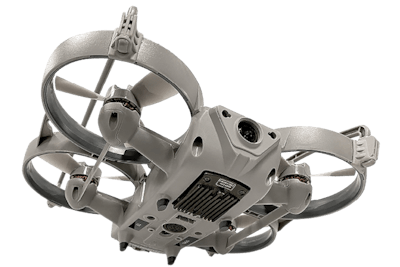 The Sky-Hero Loki Mk2 is a drone that was purpose built for building searches. It features rugged construction and shielded rotors so it can be bounced off walls.
The Sky-Hero Loki Mk2 is a drone that was purpose built for building searches. It features rugged construction and shielded rotors so it can be bounced off walls.
Some of the top European counter-terrorism teams had a problem. Most of their operations involved going into buildings, but the drones they relied on for gathering potentially life-saving intelligence about the locations of suspects were not built for flying indoors. So, they asked Belgian drone maker Yves Coppye at Sky-Hero for a solution.
Sky-Hero developed the Loki Mk1, a compact drone designed to fly inside buildings and allow the good guys to search for the bad guys. It worked but it required an expert drone pilot to keep it in the air. The problem was that the Loki Mk1 did not offer stabilization. “Operators had to spend a lot of time thinking about flying it,” says Jon Becker, CEO of Aardvark Tactical.
Sky-Hero’s engineers listened to input from American and European tactical teams and went back to the drawing board. The result is the Loki Mk2, which was released earlier this year and is exclusively distributed in North America by Aardvark Tactical.
The Loki Mk2 is even more of a purpose-built tool than the first Loki. It’s purpose is to “place a camera anywhere and gain intelligence without having to stick an operator’s head in the door,” Becker explains. The Loki Mk2’s 150-degree low-light camera can stream video to the operator in real time and with optional accessories stream to the cloud or to mobile displays.
One of the most requested upgrades for the Loki Mk2 was to make it easier to operate. Sky-Hero turned to French drone company Parrot for engineering support. Parrot helped create software that allows the Loki Mk2 to use a suite of sensors to determine its location to stabilize itself.
The Loki Mk2 also uses analog radio signals for more reliable flight. Most drones use digital streaming to send high-resolution video back to the operator and commands from the operator to the drone. You can push a lot of data on a digital signal. What you can’t do is push a digital signal into and out of a building. That’s why the Loki Mk2 uses an analog signal. “If your picture freezes while flying in a building, you won’t realize it for a second, and you’ll crash the drone,” says Becker.
Crashing the Loki Mk2 will likely affect your operation more than it will the drone. The Loki Mk2 is ruggedly constructed and features shielded rotors. “You can bounce it off walls and ceilings; fly it into attics, crawl spaces, under duct work; and you can even fly it under furniture,” Becker says. “Indoor tactical flight is a full contact sport and often bouncing Loki off of walls and floors is required to reach the objective,” he adds.
Another purpose built feature of the Loki Mk2 is its infrared lighting. The IR lights, on the front and bottom of the drone, serve at least two purposes: They let the drone’s zero lux camera provide operators with intelligence in total darkness. And they light up rooms for operators wearing night vision. “Loki has happy dog mode’” Becker explains. “It allows you to fly it into a room, turn it over and switch on its IR lights for use with night vision.”
The Loki Mk2 can be launched by hand—literally thrown—or from the ground. It has a flight time of 16 minutes but can be landed ( “perched”) and used as a surveillance video and audio system for up to six hours.
Aardvark Tactical sells the Loki Mk2 for under $10,000. For that price, buyers receive two drones, a controller for up to four drones, batteries, and a charger. A purpose build Project 7 backpack for carrying the system in a stack is available as an option.


